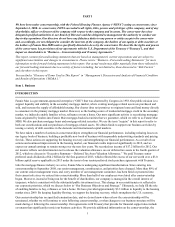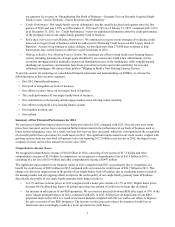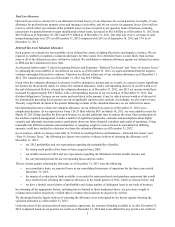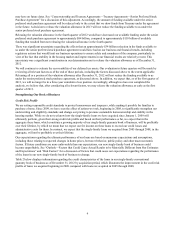Fannie Mae 2012 Annual Report Download - page 16
Download and view the complete annual report
Please find page 16 of the 2012 Fannie Mae annual report below. You can navigate through the pages in the report by either clicking on the pages listed below, or by using the keyword search tool below to find specific information within the annual report.
11
“Risk Management—Credit Risk Management—Single-Family Mortgage Credit Risk Management—Problem Loan Management—
Loan Workout Metrics” for additional information on our various types of loan workouts.
(11) Calculated based on annualized problem loan workouts during the period as a percentage of delinquent loans in our single-family
guaranty book of business as of the end of the period.
Our single-family serious delinquency rate has decreased each quarter since the first quarter of 2010. The decrease in our
serious delinquency rate is primarily the result of home retention solutions, foreclosure alternatives and completed
foreclosures, as well as our acquisition of loans with stronger credit profiles since the beginning of 2009.
Although our serious delinquency rate has decreased, our serious delinquency rate and the period of time that loans remain
seriously delinquent continue to be negatively impacted by the length of time required to complete a foreclosure. High levels
of foreclosures, changes in state foreclosure laws, new federal and state servicing requirements imposed by regulatory actions
and legal settlements, and the need for servicers to adapt to these changes have lengthened the time it takes to foreclose on a
mortgage loan in many states. The length of the foreclosure process, the pace of loan modifications and changes in home
prices and other macroeconomic conditions all influence serious delinquency rates. We expect the number of single-family
loans in our legacy book of business that are seriously delinquent to remain well above pre-2008 levels for years. In addition,
we anticipate that it will take a significant amount of time before our REO inventory is reduced to pre-2008 levels.
We provide additional information on our credit-related expenses or income in “Consolidated Results of Operations—Credit-
Related (Income) Expenses” and on the credit performance of mortgage loans in our single-family book of business and our
loan workouts in “Risk Management—Credit Risk Management—Single-Family Mortgage Credit Risk Management.”
Contributions to the Housing and Mortgage Markets Since Entering Conservatorship
Liquidity and Support Activities
We have provided approximately $3.3 trillion in liquidity to the housing market since 2009, enabling families to buy,
refinance or rent a home. Since we entered into conservatorship in September 2008, we have provided critical liquidity and
support to the U.S. mortgage market in a number of important ways:
• We serve as a stable source of liquidity for purchases of homes and financing of multifamily rental housing, as well
as for refinancing existing mortgages. The approximately $3.3 trillion in liquidity we have provided to the mortgage
market from 2009 through 2012 through our purchases and guarantees of loans enabled borrowers to complete 9.7
million mortgage refinancings and 2.7 million home purchases and provided financing for 1.7 million units of
multifamily housing.
• We strengthened our underwriting and eligibility standards to support sustainable homeownership. As a result, our
new single-family book of business has a strong credit risk profile. Our support enables borrowers to have access to
a variety of conforming mortgage products, including long-term, fixed-rate mortgages, such as the prepayable 30-
year fixed-rate mortgage that protects homeowners from interest rate swings.
• Through our loan workout efforts from 2009 through 2012, which included providing over 879,000 loan
modifications, we helped 1.2 million homeowners stay in their homes or otherwise avoid foreclosure. These efforts
helped to support neighborhoods, home prices and the housing market.
• We helped borrowers refinance loans. From April 1, 2009, the date we began accepting delivery of loans through our
Refi Plus initiative, through December 31, 2012, we acquired approximately 2.8 million Refi Plus loans.
Refinancings delivered to us through Refi Plus in the fourth quarter of 2012 reduced borrowers’ monthly mortgage
payments by an average of $237. Some borrowers’ monthly payments increased as they took advantage of the ability
to refinance through Refi Plus to reduce the term of their loan, to switch from an adjustable-rate mortgage to a fixed-
rate mortgage or to switch from an interest-only mortgage to a fully amortizing mortgage.
• We support affordability in the multifamily rental market. Over 85% of the multifamily units we financed from 2009
through 2012 were affordable to families earning at or below the median income in their area.
• In addition to purchasing and guaranteeing loans, we provide funds to the mortgage market through short-term
financing and other activities. These activities are described in more detail in “Business Segments—Capital
Markets.”
2012 Acquisitions and Market Share
As the leading provider of residential mortgage credit, we enable families to buy, refinance or rent a home. During 2012, we
purchased or guaranteed approximately $918 billion in single-family and multifamily loans, measured by unpaid principal
balance, which includes $45.8 billion in delinquent loans we purchased from our single-family MBS trusts. Our 2012 single-
family acquisitions exceeded our 2011 acquisitions by more than a million loans, primarily as a result of lower interest rates
























